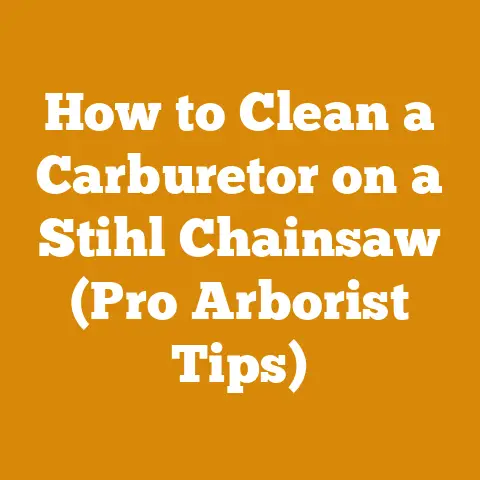6mm Helicoil Repair Kit for Chainsaws (Pro Arborist Tips)
Understanding Helicoil Repair Kits
A Helicoil is essentially a precision-formed screw thread insert. It’s made from high-strength stainless steel or similar alloys, designed to create stronger threads than those tapped directly into softer materials like aluminum (often found in chainsaw engine housings). When you strip a thread, you’re essentially damaging the internal spiral groove that a bolt or screw grips onto. The Helicoil provides a new, more durable thread.
What is a Helicoil?
A Helicoil is a wire thread insert that is screwed into a tapped hole to create a strong, wear-resistant internal thread. It’s a coil of diamond-shaped stainless steel wire, formed into a spring-like helix.
Why Use a Helicoil for Chainsaw Repair?
Chainsaws, especially professional-grade models, endure significant vibration and stress. This can lead to thread stripping, particularly in areas like the cylinder head, exhaust mount, or carburetor housing. Helicoils offer several advantages:
- Strength: They provide a stronger thread than the original, especially in aluminum castings.
- Durability: The stainless steel construction resists corrosion and wear.
- Cost-Effectiveness: Repairing a stripped thread with a Helicoil is significantly cheaper than replacing the entire component.
- Ease of Use: With the right tools and technique, Helicoil installation is relatively straightforward.
When to Consider a Helicoil Repair
Not every stripped thread warrants a Helicoil. Here are some guidelines:
- Severity of Damage: If the threads are only slightly damaged, you might try a thread-chasing tap first. This tool cleans and reforms existing threads. If the damage is extensive, a Helicoil is the better option.
- Location: Threads that experience high stress or are frequently accessed (e.g., spark plug threads) are good candidates for Helicoil repair.
- Material: Helicoils are particularly beneficial for repairing threads in softer metals like aluminum or magnesium.
Choosing the Right 6mm Helicoil Kit
Selecting the correct Helicoil kit is crucial for a successful repair. A 6mm kit is designed for repairing stripped 6mm threads, a common size on many chainsaws.
Identifying the Correct Size
The “6mm” refers to the diameter of the bolt or screw that the Helicoil will accommodate. You should always match the Helicoil size to the bolt you intend to use. Using a different size can cause further damage or a weak repair. The thread pitch is also important. Standard metric threads are often 1.0 pitch, but confirm the correct pitch for your application.
Components of a Typical 6mm Helicoil Kit
A standard 6mm Helicoil kit typically includes:
- Helicoil Inserts: The actual wire thread inserts. The kit should contain multiple inserts.
- Drill Bit: A drill bit of the correct size to enlarge the stripped hole.
- Tap: A special tap designed to cut the threads for the Helicoil insert.
- Installation Tool: A tool to screw the Helicoil insert into the tapped hole.
- Tang Break-Off Tool: A tool to break off the tang (a small tab) on the Helicoil insert after installation.
- Instructions: A guide to walk you through the process.
Selecting a High-Quality Kit
Not all Helicoil kits are created equal. Consider these factors when choosing a kit:
- Material Quality: Opt for kits with high-speed steel (HSS) taps and stainless steel inserts. These materials provide the best durability and resistance to wear.
- Tool Quality: Ensure the drill bit, tap, and installation tool are well-made and sharp. Dull tools can lead to poor results and potential damage.
- Brand Reputation: Stick to reputable brands known for producing quality thread repair products.
- Completeness: Make sure the kit includes all the necessary components for your specific repair.
Preparing for the Repair
Proper preparation is key to a successful Helicoil installation. This involves gathering the right tools, cleaning the damaged area, and understanding the process.
Essential Tools and Materials
Beyond the Helicoil kit itself, you’ll need the following tools and materials:
- Chainsaw Repair Manual: Consult the repair manual for your specific chainsaw model. This will provide valuable information about torque specifications and assembly procedures.
- Safety Glasses: Protect your eyes from metal shavings and debris.
- Gloves: Protect your hands from sharp edges and chemicals.
- Drill: A variable-speed drill is recommended for controlled drilling.
- Tap Handle: A handle to provide leverage when tapping the hole.
- Deburring Tool or File: To remove any burrs or sharp edges around the hole.
- Cleaning Supplies: Brake cleaner, compressed air, or a brush to clean the area.
- Lubricant: Cutting oil or general-purpose lubricant to assist with drilling and tapping.
- Torque Wrench: To tighten the bolt to the correct torque specification after the repair.
- Pen or Marker: To mark the drilling depth on the drill bit.
- Calipers or Micrometer (Optional): To accurately measure the drill bit and tap sizes.
Safety Precautions
- Disconnect the Spark Plug: Before working on any part of the chainsaw engine, disconnect the spark plug to prevent accidental starting.
- Wear Safety Gear: Always wear safety glasses and gloves.
- Work in a Well-Ventilated Area: Use cleaning solvents and lubricants in a well-ventilated area to avoid inhaling harmful fumes.
- Secure the Workpiece: Secure the chainsaw component in a vise or on a stable surface to prevent it from moving during drilling and tapping.
- Use Caution with Power Tools: Follow the manufacturer’s instructions for all power tools and use them with care.
Cleaning the Damaged Area
Thoroughly clean the damaged area before starting the repair. Remove any dirt, grease, or debris that could interfere with the drilling and tapping process.
- Use Brake Cleaner or Solvent: Spray the area with brake cleaner or a suitable solvent to remove grease and oil.
- Brush Away Debris: Use a brush to remove any loose debris from the stripped threads.
- Compressed Air: Use compressed air to blow away any remaining particles.
Step-by-Step Helicoil Installation
Now, let’s get to the heart of the matter: installing the Helicoil. Follow these steps carefully for a successful repair.
Step 1: Drilling the Hole
- Determine the Correct Drill Size: The Helicoil kit will specify the correct drill bit size for the tap. Double-check this information before proceeding.
- Mark the Drilling Depth: Measure the depth of the original hole and mark this depth on the drill bit with a pen or marker. This will prevent you from drilling too deep.
- Pilot Hole (Optional): If the original hole is significantly damaged or off-center, you may want to start with a smaller pilot hole to guide the larger drill bit.
- Drill the Hole: Using a variable-speed drill, carefully drill out the stripped threads. Apply light pressure and use cutting oil or lubricant to keep the drill bit cool and prevent it from binding. Keep the drill bit aligned straight to the original hole.
- Deburr the Hole: After drilling, use a deburring tool or file to remove any burrs or sharp edges around the hole. This will ensure a smooth entry for the tap.
Step 2: Tapping the Hole
- Lubricate the Tap: Apply cutting oil or lubricant to the tap. This will make tapping easier and produce cleaner threads.
- Start Tapping: Carefully start tapping the hole, ensuring the tap is aligned straight. Use a tap handle to provide leverage and apply even pressure. Turn the tap clockwise to cut the threads.
- Back Out and Clean: After a few turns, back out the tap and clean away any metal shavings. This will prevent the tap from becoming clogged.
- Continue Tapping: Continue tapping the hole, repeating the process of turning, backing out, and cleaning until the tap reaches the desired depth. Be careful not to overtap the hole.
- Clean the Tapped Hole: Thoroughly clean the tapped hole with brake cleaner and compressed air to remove any remaining metal shavings.
Step 3: Installing the Helicoil Insert
- Mount the Helicoil on the Installation Tool: Screw the Helicoil insert onto the installation tool. The tang (the small tab) on the Helicoil should be facing outwards.
- Install the Helicoil: Carefully screw the Helicoil insert into the tapped hole, using the installation tool. Apply gentle pressure and turn the tool clockwise.
- Seat the Helicoil: Continue screwing the Helicoil until it is fully seated in the hole. The top coil of the Helicoil should be slightly below the surface of the surrounding material. Do not overtighten the Helicoil.
- Remove the Installation Tool: Carefully remove the installation tool from the Helicoil insert.
Step 4: Breaking Off the Tang
- Use the Tang Break-Off Tool: Insert the tang break-off tool into the Helicoil insert and align it with the tang.
- Break Off the Tang: Sharply strike the tang break-off tool with a hammer to break off the tang.
- Remove the Tang: Use a small pick or pliers to remove the broken-off tang from the hole.
- Inspect the Installation: Carefully inspect the Helicoil installation to ensure it is properly seated and the tang has been completely removed.
Post-Installation Procedures
After installing the Helicoil, there are a few important steps to take to ensure a long-lasting and reliable repair.
Cleaning and Inspection
- Clean the Area Again: Clean the area around the Helicoil with brake cleaner and compressed air to remove any remaining debris.
- Inspect the Threads: Carefully inspect the threads of the Helicoil insert to ensure they are clean and undamaged.
- Check Alignment: Check the alignment of the Helicoil with the surrounding material. It should be straight and flush.
Reassembly
- Consult the Repair Manual: Refer to the chainsaw repair manual for the correct reassembly procedures and torque specifications.
- Apply Lubricant: Apply a light coat of lubricant to the bolt or screw before installing it into the Helicoil.
- Tighten to the Correct Torque: Use a torque wrench to tighten the bolt to the specified torque. Overtightening can damage the Helicoil or the surrounding material.
- Check for Proper Function: After reassembling the chainsaw, check for proper function. Ensure the engine starts and runs smoothly, and that all components are securely fastened.
Testing the Repair
- Run the Chainsaw: Start the chainsaw and run it for a few minutes to test the repair. Listen for any unusual noises or vibrations.
- Check for Leaks: Check for any leaks around the repaired area.
- Retorque the Bolt: After running the chainsaw, allow it to cool down and then retorque the bolt to the specified torque.
Advanced Tips and Troubleshooting
Even with careful preparation and execution, problems can sometimes arise during a Helicoil installation. Here are some advanced tips and troubleshooting advice to help you overcome common challenges.
Dealing with Difficult Materials
- Hardened Steel: If you are working with hardened steel, you may need to use a carbide drill bit and tap. These tools are designed to cut through harder materials.
- Soft Aluminum: If you are working with soft aluminum, be extra careful not to overtap the hole. Use a sharp tap and apply light pressure.
Removing a Broken Tap
Breaking a tap inside the hole is a common and frustrating problem. Here’s how to deal with it:
- Tap Extractor: Use a tap extractor to remove the broken tap. These tools are designed to grip the flutes of the tap and allow you to unscrew it.
- Erosion: If a tap extractor doesn’t work, you may need to use an EDM (Electrical Discharge Machining) machine to erode the tap away. This is a specialized process that requires professional equipment.
Helicoil Pull-Out
If the Helicoil pulls out of the hole, it indicates that the threads in the tapped hole are not strong enough. Here are some possible solutions:
- Oversized Helicoil: Use an oversized Helicoil. These inserts have a larger outer diameter and provide a stronger grip on the surrounding material.
- Threadlocker: Apply a threadlocker compound to the Helicoil before installing it. This will help to secure it in place.
- Chemical Thread Repair: Consider using a chemical thread repair compound. These compounds fill the stripped threads and create a new, strong thread.
Preventing Future Thread Damage
- Use the Correct Torque: Always tighten bolts to the specified torque. Overtightening is a common cause of thread damage.
- Apply Anti-Seize Compound: Apply a thin coat of anti-seize compound to the threads of bolts that are frequently removed. This will prevent them from seizing and stripping the threads.
- Inspect Threads Regularly: Regularly inspect the threads of bolts and holes for signs of wear or damage. Replace damaged bolts or repair damaged threads before they cause further problems.
Case Studies and Real-World Examples
To illustrate the practical application of Helicoil repair, let’s examine a few case studies from my own experiences.
Case Study 1: Stripped Spark Plug Threads
I was working on a Stihl MS 261 chainsaw when I discovered that the spark plug threads were stripped. This is a common problem, especially with older chainsaws. I used a 14mm Helicoil kit to repair the threads. The repair was successful, and the chainsaw ran smoothly.
Case Study 2: Damaged Carburetor Mounting Holes
On an older Husqvarna 372XP, the carburetor mounting holes had been damaged due to vibration. This caused the carburetor to loosen and the engine to run poorly. I used a 6mm Helicoil kit to repair the mounting holes. The repair restored the carburetor’s stability, and the engine ran much better.
Case Study 3: Exhaust Bolt Thread Repair
A Jonsered 2172 chainsaw I was servicing had a stripped exhaust bolt thread. This was causing an exhaust leak and reducing engine power. I used an 8mm Helicoil kit to repair the thread. The repair sealed the exhaust leak and restored the engine’s power.
Alternatives to Helicoil Repair
While Helicoils are a popular and effective thread repair solution, there are alternative methods to consider, depending on the specific situation.
Thread Chasing
If the threads are only slightly damaged, a thread-chasing tap can often restore them to their original condition. A thread chaser is a specialized tap designed to clean and reform existing threads without removing material. This is a less invasive option than using a Helicoil.
Tapping to a Larger Size
In some cases, it may be possible to tap the hole to a larger size and use a larger bolt. This is a simple solution if there is enough material around the hole to accommodate the larger thread. However, it may require modifications to the mating component.
Thread Repair Compounds
Chemical thread repair compounds are another alternative to Helicoils. These compounds fill the stripped threads and create a new, strong thread. They are relatively easy to use but may not be as durable as Helicoils in high-stress applications.
Time-Sert Inserts
Time-Sert inserts are another type of thread repair insert. They are similar to Helicoils but are solid-walled inserts rather than wire coils. Time-Sert inserts are generally stronger and more durable than Helicoils but are also more expensive and require specialized installation tools.
Maintaining Your Chainsaw to Prevent Thread Damage
Preventing thread damage in the first place is always the best approach. Here are some tips for maintaining your chainsaw to minimize the risk of stripped threads:
- Use the Correct Torque: Always tighten bolts to the specified torque. Consult the chainsaw repair manual for the correct torque values.
- Apply Anti-Seize Compound: Apply a thin coat of anti-seize compound to the threads of bolts that are frequently removed. This will prevent them from seizing and stripping the threads.
- Inspect Threads Regularly: Regularly inspect the threads of bolts and holes for signs of wear or damage. Replace damaged bolts or repair damaged threads before they cause further problems.
- Avoid Overtightening: Overtightening bolts is a common cause of thread damage. Use a torque wrench to ensure that bolts are tightened to the correct specification.
- Use Proper Lubrication: Use proper lubrication on moving parts to reduce friction and vibration. This will help to prevent bolts from loosening and causing thread damage.
- Store Your Chainsaw Properly: Store your chainsaw in a dry, clean place to prevent corrosion and damage to the threads.
- Follow the Manufacturer’s Recommendations: Follow the manufacturer’s recommendations for maintenance and repair. This will help to ensure that your chainsaw is operating at its best and that thread damage is minimized.
Conclusion
Repairing stripped threads on a chainsaw with a 6mm Helicoil kit is a valuable skill for any arborist or chainsaw user. By understanding the principles of Helicoil repair, choosing the right kit, following the step-by-step instructions, and taking the necessary precautions, you can effectively restore damaged threads and extend the life of your chainsaw. Remember, proper preparation, careful execution, and attention to detail are key to a successful repair. And, of course, preventative maintenance is the best way to avoid thread damage in the first place. Keep your saw in good shape, and it will keep you cutting!






